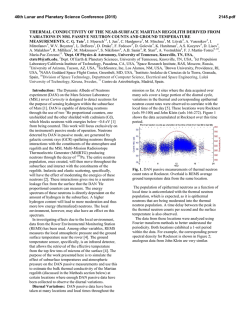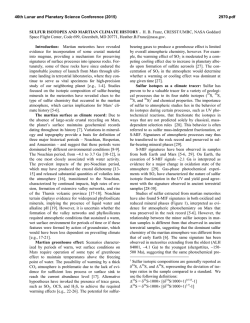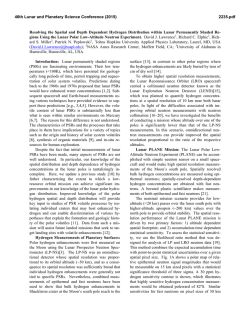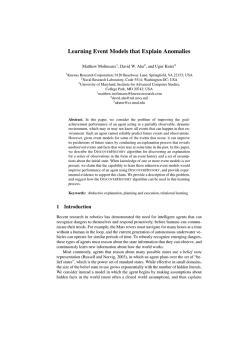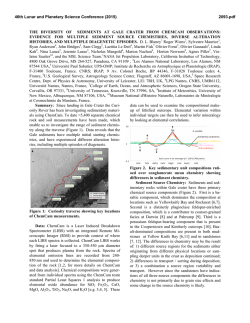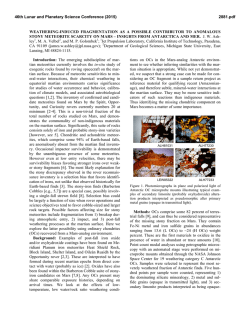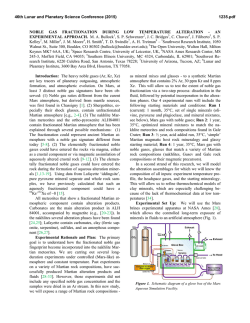
HIGH SENSITIVITY SUBSURFACE ELEMENTAL COMPOSITION
46th Lunar and Planetary Science Conference (2015) 2365.pdf HIGH SENSITIVITY SUBSURFACE ELEMENTAL COMPOSITION MEASUREMENTS WITH PING. A. M. Parsons1, L. G. Evans1,2, S. Karunatillake3, T. P. McClanahan1, J. E. Moersch4, S. F. Nowicki1,5, J. S. Schweitzer6, R. D. Starr1,7, S. Squyres8 and G.J. Taylor9 1 NASA Goddard Space Flight Center, Code 691, Greenbelt, MD 20771, [email protected], 2Computer Sciences Corporation, Lanham, MD 20706, 3Louisiana State University, Baton Rouge, LA 70803, 4University of Tennessee, Knoxville, TN 37996, 5Universities Space Research Association, Columbia, MD 21044, 6University of Connecticut, Storrs, CT 06269, 7Catholic University of America, Washington, DC 20064, 8Cornell University, Ithaca, NY 14853, 9University of Hawaii, Honolulu, HI 96822. Introduction: The Probing In situ with Neutrons and Gamma rays (PING) instrument can measure the bulk elemental composition of the subsurface (0.3 – 0.5 m) of any solid solar system body and is a versatile, effective tool for a host of scientific investigations, including detailed local geochemical analysis, and the search for chemical and isotopic markers of astrobiological niches. PING would also excel at precision surveys of subsurface materials for analysis and selection for sample return missions. PING would enhance the science return of myriad future landed missions. Due to the penetrating nature of its high-energy neutrons and gamma rays, PING could see through the walls of a landed Venus probe. PING would neither need to be deployed nor would samples need to be brought into the probe for PING to perform its analysis as part of a Venus In Situ Explorer. The PING technology is ideally suited for in situ analysis and sample return missions to the Moon, the surface of a comet, NEOs, as well as for Mars sample return missions. In fact, PING can play an important role in any landed portion of the future Mars program. PING is thus a versatile instrument that can fill an important niche in NASA’s Planetary Science Exploration Program. Instrument Technology Description: PING consists of a pulsed neutron generator (PNG), a Gamma Ray Spectrometer (GRS), and neutron detectors. 14 MeV neutrons emitted isotropically from the PNG penetrate the surface to a depth of 0.5 - 1 m (depending on regolith density) and interact with the material to produce characteristic gamma rays with energies specific to the regolith isotopes. Detected lines in the resulting gamma ray spectra indicate which elements are present and the line intensities measure the quantity of each element. See Figure 1 for an illustration of the gamma-ray generation process when using a PNG. The use of a PNG rather than Galactic Cosmic Rays (GCR) as the neutron source offers a 100x increase in count rate leading to measurement times on the order of 10 minutes rather than 8-10 hours (see Figure 2). Such quick measurement turnaround on the same time scale as typical rover motion allows bulk composition information to inform rover operations. Figure 1. PING’s PNG excites the nuclei in the soil resulting in the emission of characteristic gamma rays. The detection of these gamma rays by the GRS yields the elemental composition. Fast PNG neutrons that interact via elastic scattering in the soil are slowed and can emerge from the surface as moderated neutrons. The energy and time distribution of these moderated neutrons are primarily indicative of the hydrogen content and its layered structure, as well as the abundance of high thermal neutron capture cross section elements, such as Cl or Fe [1]. Thus measuring both gamma ray and neutron time and energy spectra characterizes different properties of the planetary regolith. Since the interpretation of neutron-only measurements is highly dependent on composition, the addition of gamma-ray data facilitates the quantification of both the geochemical composition and H concentrations. Combining the two measurements in one instrument is thus highly synergistic. While the Dynamic Albedo of Neutrons (DAN) instrument on the Mars Science Laboratory (MSL) uses some of the same principles as PING, it is missing the crucial gamma ray component, and can only infer the existence of hydrogen and the net effect of some thermal neutron-absorbing elements. PING, however, can perform complete geochemical assays of nearly all relevant elements, including H, C, O, Na, Mg, Al, Si, P, S, Cl, K, Ca, Ti, Fe, Th, and U. Operational Advantages and Capabilities: The ~ 0.5 m penetration depth of the PNG neutrons allows an 46th Lunar and Planetary Science Conference (2015) assay of subsurface composition without the need for extracting samples. Because the fast neutrons are emitted isotropically, the measurement volume is approximately a 0.5 m radius hemisphere beneath PING. Averaging over this volume reduces the effects of small highly localized anomalies. PING thus produces the bulk elemental composition of a given location and provides chemical context for measurements by other instruments. For example, since X-rays are much less penetrating than high-energy gamma rays, X-ray instruments such as APXS and XRF can only surficially probe small spots (~few mm radius, ~100 microns deep). Since PING provides the same elemental composition information, X-ray and gamma-ray instruments are quite complementary – especially when identifying and characterizing processes that have modified external surfaces, such as chemical weathering. PING measurements of elemental composition can also be used to infer mineralogy and can be valuable as a check on the mineralogical interpretations of infrared spectroscopic measurements... When placed on a rover, PING can be sent out as part of a robotic reconnaissance mission to quickly map an area, searching for the best locations to find material for either sample selection for sample return missions or In Situ Resource Utilization (ISRU). Computer Simulations and PING Sensitivity Estimates: PING was proposed for inclusion in the Mars 2020 payload as an instrument that could measure subsurface elemental composition and indicate the most favorable locations for taking samples to be placed in a returnable cache. To that end, sophisticated computer simulations were performed to determine PING’s sensitivity both in “active mode” with the PNG on and in “passive mode” where the PNG is turned off and the fast neutrons are produced by GCR interactions and the rover’s Multi-Mission Radioisotope Thermoelectric Generator (MMRTG) power source. We will present the results of these simulations as examples of how quickly PING can determine relevant subsurface compositional changes. The gamma-ray energy distribution and flux of the neutrons that produce them depends on the particle source energy distribution (GCR, MMRTG, or PNG) and the elemental composition of the regolith. PING’s expected sensitivities are based on model calculations using the Monte Carlo N-Particle eXtended (MCNPX) radiation transport code [2] routinely used for such simulations. Model calculations for PING active measurements assume a source neutron energy of 14.1 MeV, a pulse width of 100 µs, pulse period of 1000 µs, and 105 neutrons per pulse. Passive measurements, other than for the radioactive nuclides (K, Th, U), depend on the GCR spectrum and the spectrum of neu- 2365.pdf trons from the MMRTG. In all cases, the Martian atmosphere and an MSL rover model [3,4] were part of the calculations contributing to the gamma-ray signal. The position of the PING neutron generator and detector used in the model was the same as for the DAN instrument on MSL [5]. The elemental abundances simulated are derived from the reference Martian basalt composition from Blake et al. [6] containing 1 wt% water equivalent hydrogen. Figure 2 shows simulated 10 minute measurements of PING Cl/Si vs H/Si gamma-ray count rate ratios for six different Martian soil compositions (with 1σ error bars). Here, a 10 cm thick layer of Martian basalt lies on top of various Martian compositions taken from previous Mars Exploration Rover (MER) and MSL rover measurements. Note how well these varied subsurface compositions are differentiated by PING. Differences between these simulations and results obtained on Mars will be largely due to systematic errors that include, for example, errors in the model description of the rover (geometry and material composition) compared to the actual rover. These computer simulations were validated with data taken during PING prototype tests at a unique neutron generator test site at GSFC [7,8]. Figure 2. Modeled PING 10-min (1 sigma) count rate ratios for 10 cm of Martian basalt over 5 different MER and MSL-rover identified compositions. References: [1] Hardgrove, C., et al. (2011), NIM-A, 659, 442-455; [2] Pelowitz, D. B. ed. (2005), “MCNPX User’s Manual, Version 2.5.0”, Los Alamos Natl. Lab., Rep. LA-UR-94–1817, 473.; [3] Jun, I. et al. (2013), J. Geophys. Res., 118, 2169.; [4] Tate, C.G., et al., (2015), submitted to Icarus.; [5] Mitrofanov, I. G. et al. (2012), Space Sci. Rev., 170, 559–582.; [6] Blake, D.F. et al. (2013), Science, 341, 6153.; [7] Parsons, A. M. et al. (2011) NIM-A, 652, 674–679.; [8] Parsons, A. M. et al. (2013), Proceedings of the 2013 IEEE Aerospace Conference, 1–11.
© Copyright 2025
